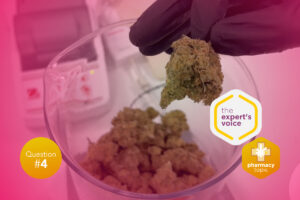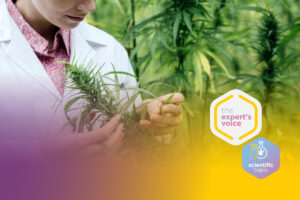ABSTRACT
Cannabis sativa is a dioecious plant that is widely distributed in areas with a temperate climate. The plant has three main varieties, each with its own chemical and morphological characteristics: hemp (Cannabis sativa), Indian hemp (Cannabis indica), and Russian or American hemp (Cannabis ruderalis). The chemical compounds produced by cannabis, known as secondary metabolites, serve various functions for the plant, including defense against herbivores and protection against physical stresses. While there are numerous other cannabinoids with potential pharmacological activity, delta 9-tetrahydrocannabinol (THC) and cannabidiol (CBD) are by far the most studied phytocannabinoids.
This article emphasizes the uniqueness of each cannabis variety and highlights the importance of considering each variety as a distinct medicine. It also provides information on the varieties of cannabis available in Italy, classified based on their origin and THC/CBD content. Furthermore, it underscores the complexity and diversity of cannabis chemotypes, emphasizing the need for further research to fully understand the pharmacological potential of the plant’s chemical constituents.
Chemotypes of cannabis
Cannabis sativa is a spontaneously germinating annual herbaceous plant native to central Asia and areas near the Himalayan mountains. Endowed with remarkable environmental adaptability, it is widespread in all areas with a temperate climate. Iran, Nepal, Syria, Arabia and Europe are rich in it.
It is a dioecious plant belonging to the Cannabaceae family and although there remains some confusion about the botanical assignment of this species, it is now preeminent in the scientific community for the identification of a single polymorphic species, Cannabis sativa, and its different varieties. Some authors define “drug-type” plant varieties with high THC content and “fiber-type” plant varieties with high content of CBD; however, the most important varieties, initially identified as true species according to the classification of Soviet botanist D.E. Janichewsky, are the:
- Cannabis sativa (hemp): the most common, up to three meters tall, very resinous and shaped pyramidal.
- Cannabis indica (Indian hemp): shorter and with more branches and leaves.
- Cannabis ruderalis (Russian or American hemp): no more than half a meter tall and without branches.
In addition to these so-called stabilized varieties of hemp, countless hybrid varieties have been created, mostly as a result of human manipulation, with the aim of enhancing or depressing some of the characteristics of the plant. Different varieties of Cannabis vary in obvious morphological characteristics, such as stem height, leaf shape, frequency of nodes on the stem, flowering period, and less obvious but equally important, characteristics relating to their chemical composition.
All plants produce a number of chemical compounds (called secondary metabolites) that are used by the plant itself for various functions that are essential for its survival and for its relationship with the environment, including:
- defense against herbivores (insects, vertebrates), pathogens and other plants;
- pollinator attraction and communication signals between symbiont organisms;
- protection against UV rays, oxidation and other physical stresses.
Often, these chemical compounds also have a biological/pharmacological action for humans: the use of plants by humans as therapeutic agents is based precisely on the presence of such substances. Cannabis is no exception and produces thousands of compounds belonging to the class of alkaloids, flavonoids, terpenes, etc. However, the phytocannabinoids are the plant’s most typical class of substances; they are produced predominantly in the inflorescences of female plants, at the level of small epidermal appendages, known as trichomes, of various shapes (glandular, peltate, crystalized), visible even to the naked eye. There are 300 types described to date (Handbook of Cannabis by Roger G. Pertwee). Different varieties of Cannabis sativa may differ substantially in their delta 9-THC and CBD content; in this respect the German Pharmacopoeia (DAB), in the Monograph Cannabisblüten, identifies three groups of inflorescences:
- Plants with predominant THC content: group I_ delta 9-Tetrahydrocannabinol >> Cannabidiol
- Plants with similar THC and CBD content: group II_ delta 9-Tetrahydrocannabinol ≈ Cannabidiol
- Plants with predominant CBD content: group III_ delta 9-Tetrahydrocannabinol << Cannabidiol
Within each group, different varieties of cannabis are identified, with delta 9-Tetrahydrocannabinol and Cannabidiol contents sometimes very similar to each other; however, each variety has a chemical profile (fingerprint) so unique that no one variety can be superimposed on another; there are no chemically interchangeable/replaceable varieties.
In conventional medicine, the effectiveness of a pharmacological treatment depends not only on the choice of a single active ingredient but also on its correct formulation from a technical and biopharmaceutical point of view. In the field of phytotherapy (herbal medicine) the sustainability of the concept of bioequivalence and substitutability is extremely complicated as each plant is a complex and unique container of chemical substances.
The potential pharmacological use of cannabis cannot be attributed just to its cannabinoid content, of which the delta 9-THC and CBD are those primarily mentioned, but to the entire phytocomplex. Cannabis has a phytochemistry that goes beyond the phytocannabinoid class itself. The total number of constituents identified is constantly growing:
- in 1980, 423 components were identified (Turner et al. 1980);
- in 1995, the number of members reached 483 (Ross and ElSohly 1995);
- between 1995 and 2005, 8 components were further added (ElSohly and Slade 2005);
To date, research groups have identified a chemical set of approximately 130 phytocannabinoids and 22 classes of non-cannabinoid constituents (isolated between 2005 and 2012), particularly terpenes, for a total number of constituents amounting to approximately 600 components. Among the cannabinoids, delta 9-THC and CBD are the most studied and important, but also significant are cannabinol (CBN), cannabigerol (CBG), tetrahydrocannabivarin (THCV), cannabicromene (CBC), cannabielsoin (CBE), cannabivarin (CBV), cannabidivarin (CBDV) and the new cannabinoids identified in 2020 (-)-trans-Δ9-tetrahydrocannabiforol (Δ9-THCP), the corresponding cannabidiforol (CBDP), Cannabidiexol (CBDH) and Tetrahydrocannabiexole (THCH) which have been shown to have pharmacological activity superior to that of delta 9- THC by up to 30 times.
Terpenes are relatively simple and extremely volatile molecules. Their volatility is responsible for the odorous character of the plant with the function of protecting against external aggression and attracting or repelling by smell animals that may respectively pollinate the flowers or eat the plant. Some terpenes have therapeutic properties recognized by traditional medicine and are also present in other plants and more characteristic in other plants, such as linalool in lavender (anxiolytic especially for the sense of smell), limonene in lemon, beta-caryophyllene in pepper (anti-inflammatory analgesic), myrcene in hops (hypnotic and muscle relaxant). The specific extraction of terpenes from plants produces an oil, called essential oil, which is a concentrate of ‘actives’ to be used in just a few drops and is the basis of aromatherapy.
Many publications discuss the “entourage” effect of terpenes with cannabinoids, i.e., the ability of terpenes to interact pharmacologically with cannabinoids by influencing their pulmonary and intestinal absorption, receptor binding and distribution across the blood-brain barrier. To date, however, there is no scientific evidence, nor are these mechanisms of interaction yet clear.
In order to proceed with a systematic approach in therapy, it is essential to consider each variety of cannabis as a medicine itself.
To date, the varieties of cannabis available in Italy can be identified:
- According to origin:
- Imported by the Dutch Ministry of Health (WTO): cannabis produced by the company Bedrocan BV and imported exclusively through companies authorized by the Italian Ministry of Health;
- imported through the Military Pharmaceutical Chemical Plant: cannabis imported following public tenders issued by the Defence Industries Agency (AID);
- National production: cannabis produced by the only authorized production site in Italy, the Military Pharmaceutical Chemical Plant in Florence.
- According to THC and CBD content:
- Cannabis inflorescences with high THC content (THC 17-26%, CBD <1%);
- Cannabis inflorescences with medium THC content (THC 12-16%, CBD<1%);
- Cannabis inflorescences with similar THC and CBD content (THC 5-8%, CBD 6-12%);
- Cannabis inflorescences with high CBD content (CBD 8-10%, THC <1%).
- According to the individual varieties and their trade names:
- Bedrocan® is considered sativa-type cannabis. Its THC level is standardized at 22%, with a CBD level of less than 1%. It is the most widely used cannabis among those offered by the Dutch Ministry and has been used more in research than other varieties.
- Bedrobinol® is considered a sativa. Its THC level can be considered medium strong, standardized at 13.5 %, with a CBD level of less than 1 %.
- Bediol® has a low to medium level of THC, standardized to 6.5% and a medium level of Cannabidiol (CBD), standardized at 8%. Bediol is available in granular form and is considered a sativa type.
- Bedica® contains an average amount of THC, around 14%, with less than 1% CBD. It is characterized by a high amount of myrcene, whereas in other varieties it is either not detectable or is to a minimal extent. Myrcene is known to have a calming effect. Bedica® is also available in granular form.
- Bedrolite® contains approximately 9% CBD and 0.4% THC; it is the only variety with a low THC value and is available in granular form.
- FM1 contains between 13.0 and 20.0% THC, with less than 1% CBD. It is available in ground form.
- FM2 contains THC between 5.0 and 8.0%, and CBD between 7.5 and 12.0%. It is available in ground form and comes from the CINRO variety.
- Pedanios 22/1 DNK has a Danish origin, comes from the Ghost Train Haze variety, is available as a whole flower and contains, among other cannabinoids, Cannabigerol in acid form (CBGA) with a content of 3%.
- Billy Buttons has Danish origin; The drug substance is obtained from different varieties of Cannabis sativa L. and Cannabis indica L., is available as whole flower and contains 19% THC.
Bibliography
[1, 4] Romano L. and Hazekamp A. 2013. Cannabis oil: chemical evaluation of an upcoming cannabisbased medicine. Cannabinoids, 2013, 1(1); 1-11.
[2] Perrotin-Brunel, H.; Buijs, W.; van Spronsen, J.; van Roosmalen, M.J.E.; Peters, C.J.; Verpoorte, R.; Witkamp, G. Decarboxylation of Δ9-tetrahydrocannabinol: Kinetics and molecular modeling. J Mol Struct, 2011, 987(1-3), 67-73.
[3] Wang, M.; Wang, Y.; Avula, B.; Radwan, M.M.; Wanas, A.S.; van Antwerp, J.; Parcher, J. F.; ElSohly, M.A.; Khan, I.A. Decarboxylation study of acidic cannabinoids: a novel approach using ultra-high-performance supercritical fluid chromatography/photodiode array-mass spectrometry. Cannabis Cannabinoid Res, 2016, 1(1), 262-271.
[5] Citti C., Ciccarella G., Braghiroli D., Parenti C., Vandelli M. A., Cannazza G. 2016. Medicinal cannabis: Principal cannabinoids concentration and their stability evaluated by a high performance liquid chromatography coupled to diode array and quadrupole time of flight mass spectrometry method. J Pharm Biomed Anal. 2016 Sep 5;128:201-209.
[6] Pacifici R., Marchei E., Salvatore F., Guandalini L., Busardò F. P., Pichini S. 2017. Evaluation of cannabinoids concentration and stability in standardized preparations of cannabis tea and cannabis oil by ultrahigh performance liquid chromatography tandem mass spectrometry. Clin Chem Lab Med. 2017 Aug 28;55(10):1555-1563.
[7] Calvi L., Pentimalli D., Panseri S., Giupponi L., Gelmini F., Beretta G., Vitali D., Bruno M., Zilio E., Pavlovic R., Giorgi A. 2018. Comprehensive quality evaluation of medical Cannabis sativa L. inflorescence and macerated oils based on HS-SPME coupled to GC-MS and LC-HRMS (q-exactive orbitrap®) approach. Journal of Pharmaceutical and Biomedical Analysis Volume 150, 20 February 2018, Pages 208-219.
[8, 10] Carcieri C., Tomasello C., Simiele M., De Nicolò A., Avateneo V., Canzoneri L., Cusato J., Di Pierri G., D’Avolio A. 2017. Cannabinoids concentration variability in cannabis olive oil galenic preparations. J Pharm Pharmacol. 2018 Jan;70(1):143-149
[9, 11] Casiraghi A., Roda G., Casagni E., Cristina C., Musazzi U. M., Franzè S., Rocco P., Giuliani C., Fico G., Minghetti P., Gambaro V. 2018: Extraction method and analysis of cannabinoids in Cannabis olive oil preparations. Planta Medica, vol. 84 (4), pp. 242-249.
[12] Patient information of the Dutch Office of Medicinal Cannabis at
http://www.cannabisbureau.nl/en/MedicinalCannabis/Patientinformation/).
[13,14] DECRETO 9 novembre 2015 Funzioni di Organismo statale per la cannabis previsto dagli articoli 23 e 28 della convenzione unica sugli stupefacenti del 1961, come modificata nel 1972. (15A08888) (GU n.279 del 30-11-2015).
[15,16,17] An introduction to Medicinal Cannabis Dr. Arno Hazekamp.
[17,18] Ministero della Salute DGDSFC/ I.6.b /2016/19 Documento recante raccomandazioni ai medici prescrittori di Cannabis FM-2 prodotta dallo Stabilimento Chimico Farmaceutico Militare di Firenze secondo le normative dell’UE in materia di sostanze attive, certificata GMP secondo le Good manufacturing practices dell’UE.
The column continues!
Don’t miss the next article on Production according to GACP and GMP.





